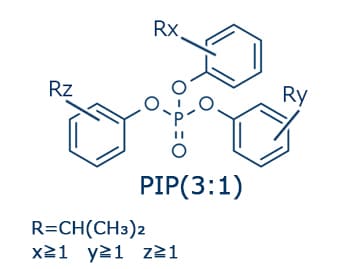PBT Chemicals under TSCA - Analysis of PIP(3:1)

Phenol, isopropylated phosphate (3:1) (PIP (3:1)) (CAS registry no. 68937-41-7) is a phosphate compound with three isopropylated phenyl groups. It is used as a plasticizer or flame retardant in polyvinyl chloride (PVC), polyurethane, and other plastic materials. Due to its wear resistance and compression resistance, this compound is also used in a wide variety of materials, such as hydraulic fluids, lubricating oils, coatings, adhesives, sealants, and plastic articles.
In 2021, under Section 6(h) of the Toxic Substances Control Act (TSCA), the United States Environmental Protection Agency (U.S. EPA) addressed the problem of PIP (3:1) as a substance that has all three characteristics of a persistent, bioaccumulative, and toxic (PBT) chemical, and began to regulate the commercial process and distribution of PIP (3:1) and PIP (3:1)-containing products or articles within the United States (Table 1).
Products exported to the United States must be free of PIP (3:1). However, due to globalization and the increased complexity of supply chains, there are difficulties in determining whether a product contains PIP (3:1) or not purely through information transmitted through the supply chain.
-

-
Note: Interpretation of the regulations was performed independently by Shimadzu. For more details, such as the latest trends and exemptions, please check the U.S. EPA website (https://www.epa.gov/) or other sources.
Uses Regulated Activities Limits Date of Enforcement PIP (3:1) and PIP (3:1)-containing products or articles Commercial process and distribution Not permitted 8-Mar-22 Adhesives and sealants Commercial process and distribution Not permitted 6-Jan-25
PIP (3:1)-containing products for photographic printing Commercial process and distribution Not permitted 1-Jan-22
Applications - Analysis of PIP (3:1) in Plastic by Py/TD-GC-MS
Analysis of PIP (3:1) in Plastic by Py/TD-GC-MS
Effective analytical methods for screening include pyrolysis/thermal desorption-GC-MS (Py/TD-GC-MS) with selectivity for PIP (3:1).
The pyrolyzer/thermal desorption-GC-MS (Py/TD-GC-MS) is specified in the international standard IEC 62321-8 as a phthalate screening system. Because this system does not require organic solvents, unlike solvent extraction GC/MS methods, it is attracting interest as an environmentally- and user-friendly system.
Analysis of a Standard Solution

Fig. 2 SIM chromatogram of standard solution
A standard solution of PIP (3:1) was prepared by diluting a standard reference material of PIP (3:1) (ChironAS, P/N8777.27) with acetone. Then, an appropriate amount of the PIP (3:1) standard solution and PVC solution was added to a sample cup so that the PIP (3:1) concentration in plastic was 1,000 mg/kg. After drying the mixture at room temperature, it was measured by Py/TD-GC-MS. Fig. 2 is a SIM chromatogram of PIP (3:1), which has three isopropyl groups and a molecular weight of 452.
Related Products
Pyrolysis gas chromatography mass spectrometry
Pyrolysis gas chromatography mass spectrometry (Py-GCMS) can be used to characterize most materials including insoluble and complex materials at trace levels often without any sample pretreatment e.g. polymers, plastics, rubber, paints, dyes, resins, coatings, cellulose, wood, textiles, oils etc.





